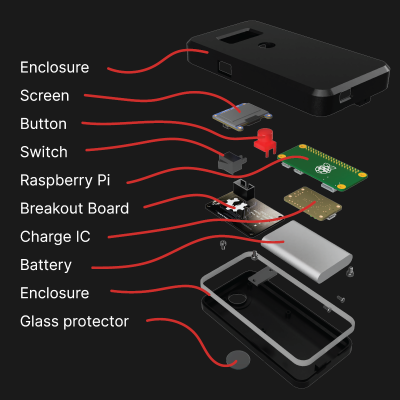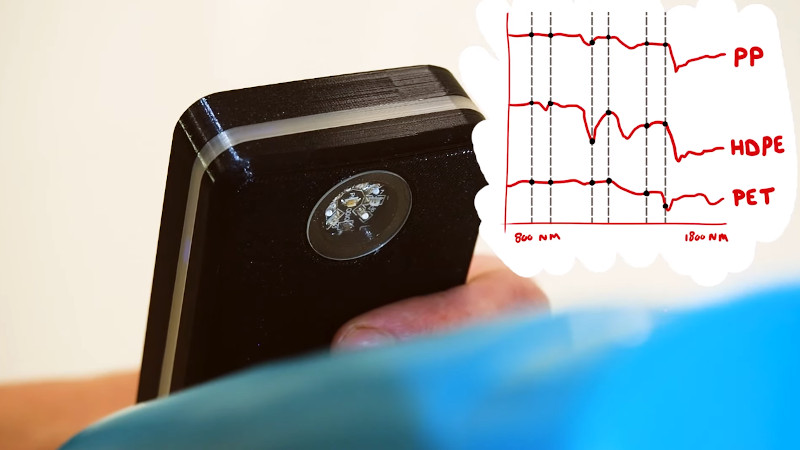One of the challenges involved in recycling plastic is determining the specific type of plastic a given item is actually made of. To keep up with demand, large scale recycling centers rely on various automated systems to separate different types of plastic from a stream of incoming material. But in less technologically advanced parts of the world, workers can find themselves having to manually identify plastic objects; a time consuming and error-prone process.
To try and improve on the situation, [Jerry de Vos], [Armin Straller], and [Jure Vidmar] have been working on a handheld open hardware device that they refer to simply enough as the Plastic Scanner. The hope is that their pocket-sized unit could be used in the field to positively identify various types of plastic by measuring its reflectivity to infrared light. The device promises to be very easy to operate, as users simply need to bring the device close to a piece of plastic, push the button, and wait for the information to pop up on the OLED display.
 Or at least, that’s the idea. While the team eventually hopes to release a kit to build your own handheld Plastic Scanner, it seems that the hardware isn’t quite ready for production. The most recent work appears to have been put in, not unexpectedly, the development board that lets the team refine their process. The development unit combines an array of IR LEDs with wavelengths ranging from 850 to 1650 nanometers, a InGaAs photodiode connected to an ADS1256 24-bit analog-to-digital converter (ADC), and an Arduino Uno. In comparison, the final hardware uses a Raspberry Pi Zero and a smaller “breakout board” that contains the sensor and IR LEDs.
Or at least, that’s the idea. While the team eventually hopes to release a kit to build your own handheld Plastic Scanner, it seems that the hardware isn’t quite ready for production. The most recent work appears to have been put in, not unexpectedly, the development board that lets the team refine their process. The development unit combines an array of IR LEDs with wavelengths ranging from 850 to 1650 nanometers, a InGaAs photodiode connected to an ADS1256 24-bit analog-to-digital converter (ADC), and an Arduino Uno. In comparison, the final hardware uses a Raspberry Pi Zero and a smaller “breakout board” that contains the sensor and IR LEDs.
Browsing through the software repository for the project, we can see the device uses Python, TensorFlow Lite, and a database of IR reflectivity values for known plastics to try and determine the closest match. Obviously the accuracy of such a system is going to be highly dependent on the quantity of known-good data, but at least for now, it appears the user is responsible for building up their own collection or IR values.
As interesting as this project is, we’re a bit skeptical about its purely optical approach to identifying plastics. Automated recycling centers do use infrared spectroscopy, but it’s only one tool of many that are employed. Without additional data points, such as the density or electrostatic properties of the plastic being tested, it seems like the Plastic Scanner would have a fairly high margin of error. Just taking into account the wide array of textures and colors the user is likely to encounter while using the device will be a considerable challenge.
[Thanks to Harvie.CZ for the tip.]
















This may have some use for single-component polymers, but very few things you run into in the real world are that. Laminates, coextrusions, copolymers, coatings, colorants, fillers, adhesives, tie layers etc. may be part of the mix and not readily apparent.
FWIW this gave me flashback terrors from having to identify these spectra manually very many years ago.
If it can reliably distinguish Delrin (acetal homopolymer) from acetal copolymer, I’m in.
sneaky ;) https://www.plasticstoday.com/materials-analyst-part-33-determining-composition
But do let us know where that has its practical application (https://www.aiplastics.com/blog/acetal-c-or-acetal-h ?) wouldn’t a an additional hardness tester do the trick?
Since multi-plastic composites are effectively unrecyclable (at least for most plastics recycling processes), that’s not so much a bug as a feature: a result of “definitely X” or “no clue” is exactly what you want for sorting.
Multiplastics may be unacceptable for “pure” single material recycling, but you’ll never get rid of the plasticizers, colorants, fillers, adhesives etc. that are used in actually using re-using plastics. All of these can interfere with the optical identification scheme in the article.
>we’re a bit skeptical about its purely optical approach to identifying plastics
It’s certainly a nice thesis work, very similar to what Lakshan Tharmakularajah, Jakob Döring, and Karl-Ludwig Krieger (2020) propose. (I poked at the paper in https://hackaday.io/project/2042-the-optical-inch/log/195001-infrared-based-sensor-system-for-contactless-monitoring-of-wetness-and-ice )
As for the industrial online analysis scenario, speed is key, so cheap, sparse data sources are a good thing from a first-principle point of view. Also consider that it may be sufficient to identify with great certainty pure plastics and reject the fraction of mixed and filled polymers, and that weathered plastic waste and composites have freshly exposed fracture surfaces when shredded. Here it’s favourable to use laser sources instead of LEDs though to get a series of spot measurements.
In which situations is this meant to be used? E.G. pre-sorting plastic waste on a beach in principle would take too long, but it’s generally quite dirty, and thus unreliable.
Don’t get me wrong, I hope this leads to a useful device, but as Thinkerer says, «This may have some use for single-component polymers, but very few things you run into in the real world are that».
And they don’t put the numbers on the dumpster at the recycling center. Then again, they don’t really recycle it. Cats more to transport it than they get for it.
https
Sent from Dr.Kevin Gaw (plastics engineer)
It seems the author knows electronic devices but not identification of plastics. Density and electrostatic properties are poor methods of identification due to the presence of myriad additives within the plastics. IR is THE tried and true rudimentary non-destructive identifier of organic macromolecules such as what is plastic.
This is a great development as a step to more technical sustainability efforts reaching the common man and i highly encourage its development and dissemination. Thanks
Those that deny reality do not have the right to deny its qualities.
“IR is THE tried and true rudimentary non-destructive identifier of organic macromolecules”
Correct. However, this device is measuring at 8 wavelengths in the NIR out to 1.65 um. Getting the IR fingerprint region is probably not going to happen any time soon for a low cost home hacker project.
I hope I’m wrong, but I suspect any attempt to build a plastics classifier on 8 channels of data from the NIR is going to end up GIGO.
It seems that IR would be feasible in a handheld. Then again I’ve no idea how powerful it’d need to be.
If this device’s developers maintain interest hopefully this gets honed by useful feedback.
What’s this new gently sceptical tone from HaD? Good to hear some actual questions about a project rather than just “they say it’s going to save the world and we believe them!”
Becouse it is a foundation of science.
Colour wheel from broken dlp scanner might help.
I found that having multiple scan points helps build up the hyperspectral cube.
Any benefit for using additional wavelengths? Might it be possible to incorporate a ML trained model for best guesses based on multi-spectral results? The idea being not to complicate the design much with more expensive spectrometers, but cheaply increase potentially useful and processable data.
IR or more specifically NIR (near infra red ) IS the technology for sorting plastics!
I have been working for company EVK (www.evk.biz) which is producing NIR line cameras, that are capable of sorting plastics, foods, minerals, etc in real time at a speed of several m/s!
That’s awesome. Seems like the tech and AI is what is catching up to be more accurate with identification which is good! Getting this tech in more people’s hands in a convenient affordable way would help far more small scale recyclers. I see what people are saying about so many different combinations of plastic types. The real root of the problem is plastic just isn’t designed to be easily recycled. No matter how much we try it just doesn’t happen. If it’s easier and cheaper to make new Plastics and costs less to dispose of the waste we’re never going to close the loop and will always be making more than we can recycle. I’m hopeful for the new laws Maine (my state) has put on plastic producers, hopefully it works and more places do it too. Personally I believe if the local recycling program doesn’t offer a recycling option for certain plastic it should be harder for any store in that town/city to sell that packaging. How can you sell something that can’t even be properly disposed of? Saying this because our recycler just cut way down on what they accept for Plastic. It’s making me want to invest in a shredder and start recovering some myself, the big thing in my way is identification. I have hopes for this!
This could be a game changer for disc golf.